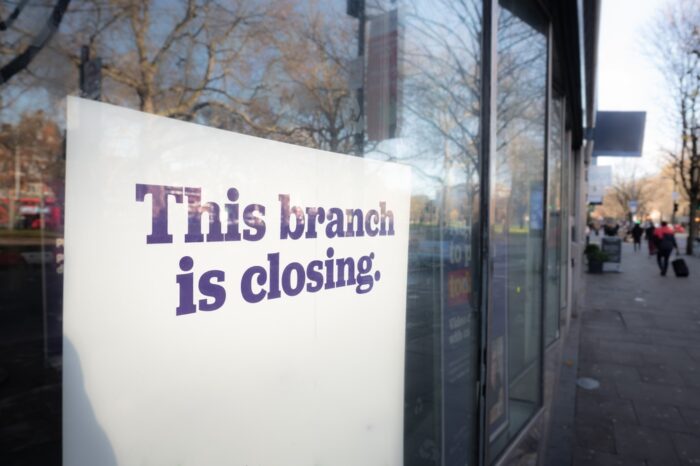Nearly three million people won’t have access to a physical bank branch in their local area by the end of 2024, analysis by a campaign group reveals.
An estimated 2.8 million people from 30 parliamentary constituencies including Reading West, Bradford South and Glasgow North East will be left out in the cold as bank branch closures continue at pace.
Analysis of branch closure data by campaign group Which? revealed that more than 5,800 banks and building societies have disappeared from the high street since 2015.
That’s the equivalent of 54 each month, with half of networks closing for good.
NatWest Group, which includes NatWest, Royal Bank of Scotland and Ulster Bank, has closed 1,333 branches – the most of any banking group. Lloyds Banking Group, which includes Lloyds Bank, Halifax and Bank of Scotland, has closed 1,072 sites.
While millions of people have switched to digital banking, Which? said “there remains a significant minority of people who are not yet ready or willing to make that jump”.
It noted figures from the British Retail Consortium which found that cash usage has actually increased amid the cost-of-living crisis, accounting for 19% of all transactions in 2022, up from 15% in 2021.
For some individuals, particularly vulnerable members of society, it’s important to access face-to-face banking services.
Which? acknowledged Post Office locations and banking hubs which allow people to carry out deposit and withdrawal services which help to plug gaps left by physical branches.
However, it said “their rollout remains too slow for consumers to feel the benefits. Currently only 30 of 101 recommended banking hub locations have opened, according to LINK data”.
Regulator the Financial Conduct Authority has been tasked with overseeing the cash network though it’s unable to prevent a bank from closing a branch.
The campaign group said the regulator must work closely with banks and “hold them accountable” for ensuring communities are not left without access to cash withdrawal and deposit facilities.
‘Communities need replacements’
Sam Richardson, deputy editor of Which? Money, said: “A closed bank branch isn’t just a high street eyesore, but one less place for consumers to go to withdraw cash or access in-person banking services.
“Which? research shows that millions of people could be without a local branch by the end of 2024 as banks continue to close at an alarming rate.
“Alternatives like banking hubs could help plug the gaps, but they are being rolled out too slowly, so more must be done to ensure communities get these replacements for their closed bank branches as soon as possible.
“It’s vital that the FCA works closely with banks and holds them accountable over decisions to close branches so more people aren’t left at risk of being cut adrift.”
The constituencies and populations impacted:
- Barnsley East 94,000
- Bolton West 98,000
- Bradford South 106,000
- Central Suffolk and North Ipswich 102,000
- Clwyd South 70,000
- Colne Valley 112,000
- Denton and Reddish 88,000
- Don Valley 99,000
- East Worthing and Shoreham 99,000
- Erith and Thamesmead 117,000
- Glasgow North East 88,000
- Liverpool, West Derby 94,000
- Mid Bedfordshire 121,000
- Mid Derbyshire 83,000
- Newport East 84,000
- North East Derbyshire 92,000
- Nottingham East 98,000
- Penistone and Stocksbridge 89,000
- Plymouth, Moor View 94,000
- Reading West 112,000
- Rhondda 68,000
- Sedgefield 85,000
- Sheffield, Hallam 85,000
- St Helens North 100,000
- Stone 86,000
- Swansea East 81,000
- Warrington North 95,000
- Wentworth and Dearne 100,000
- Wirral West 68,000
- York Outer 92,000
Related: Nearly 200 bank branches set to disappear from high streets in 2024





